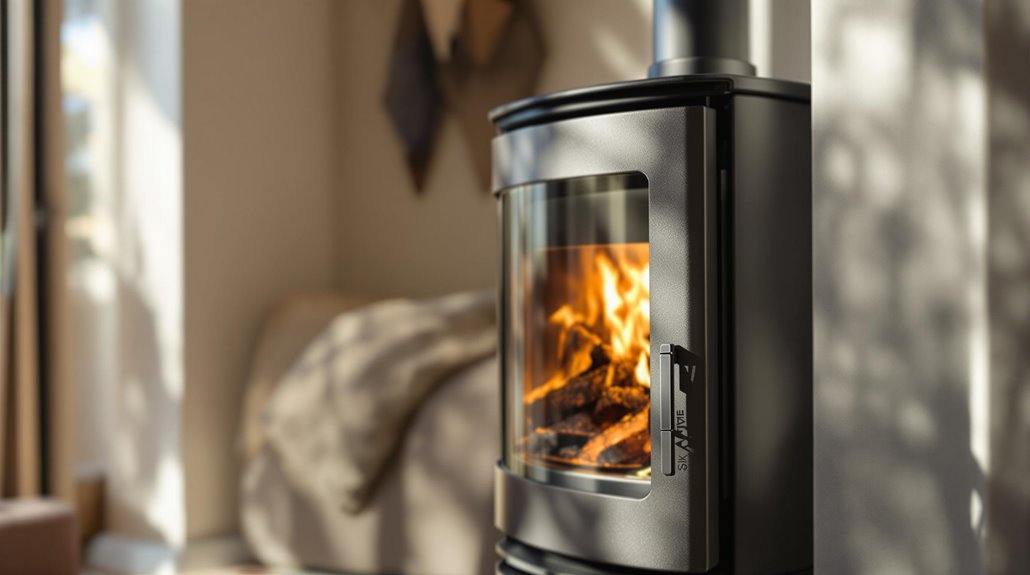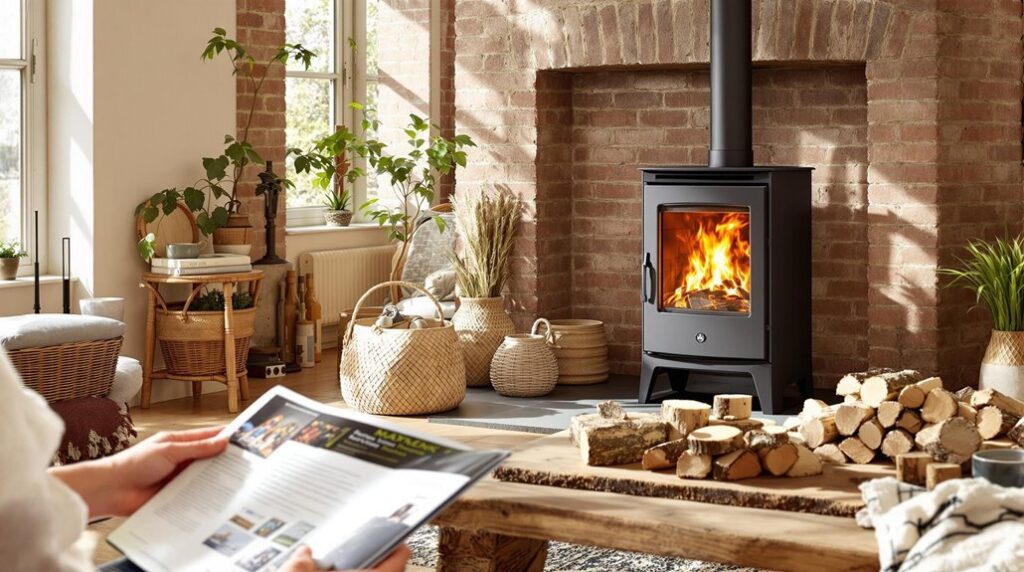I’ve installed dozens of wood burning stoves across the UK, and I can tell you that choosing the wrong one will cost you thousands in wasted fuel and potential safety issues. Most buyers focus solely on aesthetics, completely ignoring efficiency ratings and regulatory compliance that’ll make or break your heating system’s performance. Before you commit to any stove, there’s a specific calculation method I use to determine exactly what size and type will work for your space.
Key Takeaways
- Choose Ecodesign-compliant stoves with 80%+ efficiency ratings to meet UK regulations and maximize fuel conversion to heat.
- Verify DEFRA approval if installing in Smoke Control Areas using the official approved database before purchase.
- Use HETAS-certified professionals for installation to comply with Building Regulations and maintain insurance coverage validity.
- Select kiln-dried hardwood with under 20% moisture content for optimal efficiency and reduced emissions during combustion.
- Budget £500-£600 annually for maintenance including professional servicing, chimney sweeping, and minor repairs for safe operation.
Understanding Efficiency Ratings and UK Standards

When selecting a wood burning stove, understanding efficiency ratings becomes your first critical decision point. I’ll explain what these numbers actually mean for your heating setup. Efficiency measures how much fuel converts to usable heat versus waste—a 75% rating means you’re losing 25% through smoke and gases. You’ll want ratings above 75% to exceed UK minimums and maximize heat per log.
Since 2022, Ecodesign regulations mandate ≥75% efficiency for all new stoves. If you’re in smoke control areas, you’ll need DEFRA approval too. Look for Clearskies 5 certification—it identifies stoves outperforming basic standards by up to 14%. These regulations also enforce strict particulate matter limits of no more than 0.0025 g/m³ to reduce air pollution. These ratings focus purely on fuel-to-heat conversion, not heat output. Higher efficiency means lower fuel costs and cleaner burns for your home.
Top-Performing High-Efficiency Wood Burning Stoves
Which wood burning stoves actually deliver the highest efficiency ratings available today? I’ve identified the standout performers that’ll maximize your heating investment.
The Skye E700 leads with an impressive 89% efficiency, featuring I-Blu combustion intelligence that automatically optimizes air intake for cleaner burns. You’re getting microprocessor-controlled operation that adjusts in real-time.
Charnwood Aire 5 delivers 85% net efficiency at 5kW output, while the Arada Ecoburn 5 achieves 81.3% efficiency in the same power range. Both offer reliable performance for mid-sized spaces.
Burley stoves claim world-leading efficiency through their advanced heat exchanger technology. Their Bradgate 9305-C includes catalytic converters, while the 9305 earns ecoexcel rating. Both models guarantee reduced fuel consumption with 5kW nominal output and 6.4kW maximum capacity. To maximize your stove’s performance, use kiln-dried hardwood with moisture content below 20% for optimal efficiency.
Calculating the Correct Stove Size for Your Room

Having the most efficient wood burning stove won’t help if you’ve chosen the wrong size for your space. I’ll walk you through the precise calculations that’ll get you the perfect match.
First, measure your room’s length, width, and height in metres, then multiply for cubic volume. Next, divide by your insulation factor: 15 for pre-1950s homes, 20 for 1990s builds, or 25 for post-2008 properties. Large windows? Drop down one insulation tier.
Now adjust for your specific setup. Add 15% for open-plan connections, 20% for open staircases, and 10% if you prefer temperatures above 20°C. Subtract 5% for south-facing rooms or 10% for kitchens.
Your final kW requirement determines everything—get this right, and you’re sorted. Remember that larger stoves aren’t always better, as they can be tempting but inefficient for smaller spaces and may lead to overheating issues.
Comparing Different Stove Types and Their Performance
Once you’ve nailed your kW requirements, you’ll face a bewildering array of stove types that perform vastly differently in real-world conditions. I’ll break down what actually matters for your installation.
Wood-burning stoves stick to seasoned wood exclusively, while multi-fuel models handle both wood and smokeless coal through their raised grate design. If you’re considering fuel flexibility, multi-fuel wins hands-down.
Material choice dramatically affects performance. Cast iron retains heat longer after your fire dies, perfect for consistent overnight warmth. Steel heats faster but cools quicker—ideal if you want rapid temperature response. Understanding your heating options aids in making an informed decision that suits your specific needs.
Modern Ecodesign-compliant stoves achieve 80%+ efficiency versus open fires’ pathetic 15-20%. Look for DEFRA approval if you’re in smoke-controlled areas—it’s non-negotiable, not optional.
Essential UK Regulations and Certification Requirements
Performance means nothing if your stove doesn’t comply with UK regulations—you’ll face hefty fines and potentially unusable equipment. Since January 2022, only Ecodesign-certified stoves can be legally sold, requiring 75% minimum efficiency and emissions under 2.5g/kg fuel burned. I’ll help you navigate this regulatory maze.
First, check if you’re in a Smoke Control Area—65% of UK homes are. You’ll need a DEFRA-exempt stove from their online database. Any modifications void your exemption status. Additionally, it’s crucial to understand that Conservation Areas may impose further restrictions on your installation choices.
Use only compliant fuels: kiln-dried logs with ≤20% moisture or approved smokeless fuels. Wet wood’s banned since 2021.
Installation requires HETAS-certified professionals following Building Regulations. HETAS installers provide proper documentation for insurance protection and guarantee compliance with all regulations. Non-compliance triggers £175-£1,000 fines, with environmental officers conducting unannounced inspections based on neighbor complaints.
Installation Considerations and Professional Requirements
While regulations set the legal framework, proper installation requires precise attention to physical requirements that’ll make or break your stove’s performance and safety. Your hearth needs non-combustible materials like stone or concrete, extending 225mm front and 150mm sides minimum. I recommend following manufacturer clearances religiously—they override standard requirements when stricter.
You’ll need proper chimney height: 600mm above your roof and 2.3m from weather surfaces. Corner installations demand extra clearance verification, and your stove can’t block exits or traffic flow. A carbon monoxide alarm is mandatory in the same room as your wood burner for safety compliance.
Here’s what separates successful installations from disasters: using HETAS-registered professionals. They’ll handle Building Regulations notifications, perform mandatory smoke draw tests, and provide the compliance certificates your insurance requires. DIY installation isn’t worth the legal headaches.
Fuel Selection and Operating Best Practices

What separates efficient heating from smoky disappointment? I’ll tell you—proper fuel selection and technique make all the difference.
You’ll need seasoned wood with moisture content below 20%. I recommend using a moisture meter to verify readiness, as wet wood reduces efficiency by over 30% and creates dangerous creosote buildup. Hardwoods like oak and beech deliver superior calorific value compared to softwoods.
Master the top-down ignition technique for peak wood burning. Never burn treated wood, plywood, or household waste—these produce toxic emissions that’ll harm your family and equipment. Wood burning represents a carbon neutral energy source since the CO2 released during combustion matches what the tree absorbed during growth.
If you’re considering multi-fuel flexibility, remember those stoves accommodate smokeless coal and anthracite, delivering twice the energy output of seasoned wood. However, you’ll need regular ash pan maintenance and proper grate airflow management.
Long-Term Maintenance and Cost Management
Beyond mastering proper burning techniques, you’ll face ongoing ownership costs that can make or break your wood stove investment. I’ll help you budget realistically: expect £500–£600 annually for maintenance, covering professional servicing (£70–£150), chimney sweeping (£50–£100), and minor repairs (£40–£100).
You’ll need annual professional servicing and 1-2 chimney sweeps. Check door seals every 3–6 months, inspect firebricks biannually, and clean components weekly during use. Always use HETAS-registered professionals—DIY installation voids insurance. Keep your stove documentation and purchase records safe, as spare parts availability may become limited if manufacturers discontinue support after several years.
Here’s the good news: your stove typically pays for itself within 3–5 years through heating savings of £200–£600 annually. After payback, you’ll enjoy net savings of £300–£700 yearly. Source free timber when possible—it cuts fuel costs by 30–50%.
Conclusion
I’ve covered the technical essentials you’ll need for selecting the right wood-burning stove. Remember, don’t compromise on efficiency ratings below 75%, and I’d strongly recommend targeting 80%+ for peak performance. You’ll need DEFRA approval in smoke control areas, proper HETAS installation, and seasoned wood with moisture content under 20%. Calculate your room’s heat requirements carefully, and factor in long-term maintenance costs. These fundamentals will guarantee you’re making a technically sound, regulation-compliant investment.
References
- https://stovecompany.co.uk/which-wood-burning-stove-is-the-most-efficient/
- https://www.charnwood.com/news/what-are-the-most-efficient-wood-burning-stoves-in-the-uk/
- https://stovefitterswarehouse.co.uk/pages/what-size-wood-burning-stove-for-my-room
- https://houseofstoves.com/understanding-stove-efficiency-ratings-a-comprehensive-guide-for-irish-homes/
- https://blog.gr8fires.co.uk/2023/04/25/which-woodburning-stove-is-the-most-efficient/
- https://greenolivefirewood.co.uk/selecting-the-best-wood-burning-stove-for-your-home-a-comprehensive-guide/
- https://www.bowlandstoves.co.uk/blog/stove-advice-and-maintenance/measure-efficiency-wood-burning-stove/
- https://www.imaginfires.co.uk/blog/wood-burning-stoves-comparison/
- https://www.woodburnerwarehouse.co.uk/wood-burning-stove-and-multi-fuel-stove-guide
- https://burley.co.uk/wp-content/uploads/2021/09/Burley-Wood-Burning-Stoves-2020.pdf

